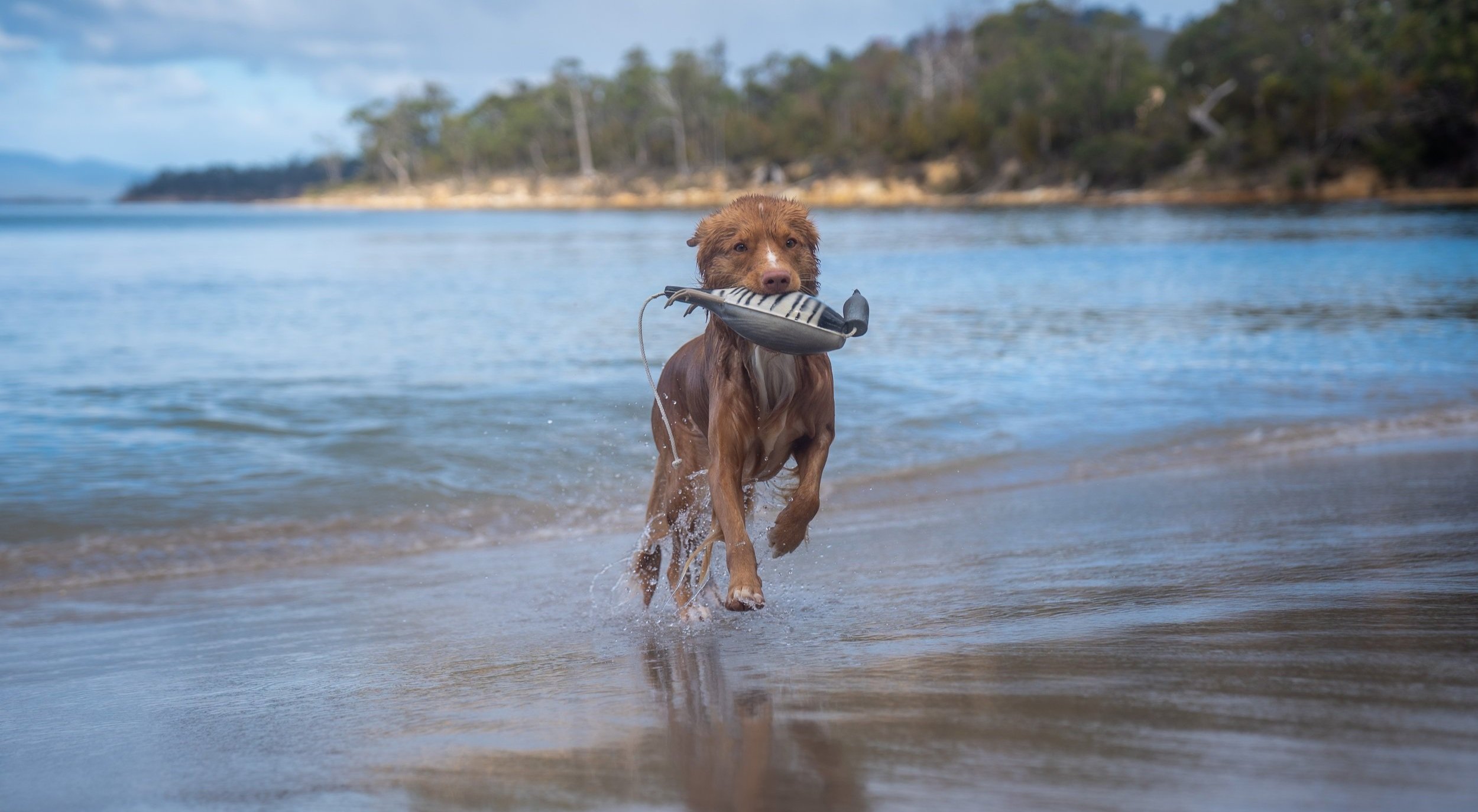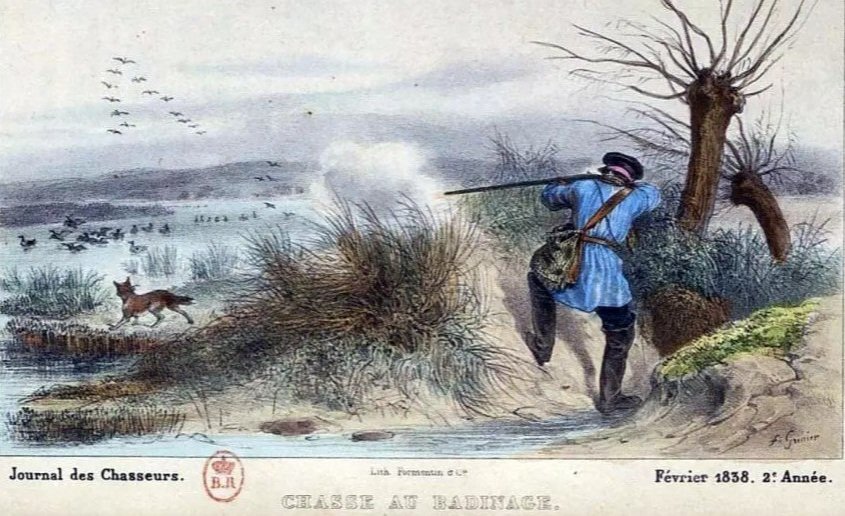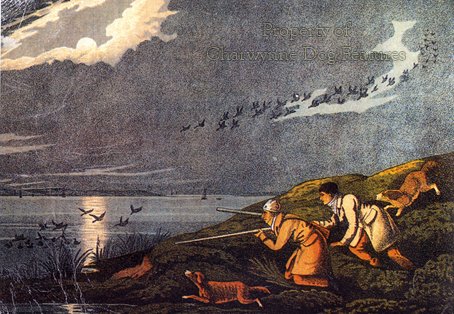
“If you are a dog man, the first time you see a tolling dog your attention will at once be arrested.”
— Henry Albert Patterson "Hap" Smith, 1915
History
Nova Scotia Duck Tolling Retrievers, or Tollers as they are more commonly known, originated in the community of Little River Harbour in Yarmouth County, Nova Scotia, around the beginning of the 19th century. The Toller was originally referred to as the Little River Duck Dog before being officially recognised by the Canadian Kennel Club in 1945 as a purebred dog. The exact origins of the breed are unknown, although likely consist of a red decoy dog of some sort, mixed with spaniel, setter and retrievers, as well as perhaps some type of collie.
“Tolling” is from the Middle English word “tollen”, which means to entice or pull. Bred to look like foxes, it was the Tollers job to entice the waterfowl within gunshot range. In the wild, a fox will play along the shoreline to draw in waterfowl. The birds become curious as they watch the playful actions of the fox and are lured to the shore where they become easy prey. Hunters inspired by the success of the foxes, trained their dogs to mimic this action by throwing sticks and rocks for the dogs to chase. The Toller is a multi-purpose gundog and along with this unique hunting style, they are also a skilled retriever. After the hunter takes his shot, the Toller is sent to fetch the downed birds from the water.
In the 1600’s, Nicholas Denys - a French-born merchant, governor and author - founded settlements in Nova Scotia and New Brunswick. His 1672 writings, The Description and Natural History of the Coasts of North America, contain the first documented account of tolling dogs:
“The wild goose or the duck keeps constantly approaching. When these are near, the foxes do not move anything but the tail. Those birds are so silly that they come even wishing to peck at the foxes. The rogues take their time, and do not fail to catch one, which pays for the trouble.
We train our dogs to do the same, and they also make the game come up. One places himself in ambush at some spot where the game cannot see him; when it is within good shot, it is fired upon, and four, five, and six of them, and sometimes more are killed. At the same time, the dog leaps to the water, and is always sent farther and farther out; it brings them back, and then is sent to fetch them all one after another.”
For those interested in a more comprehensive history of the Toller, The Nova Scotia Duck Tolling Retriever by Alison Strang and Gail MacMillan is a must read. The Nova Scotia Duck Tolling Retriever Club of Victoria website also has a number of archive pieces dating back to 1929 and details the history of the breed in Australia.
Tollers are still a rare breed in Australia, having only been here since the early nineties. In 2021, there was only 162 Toller puppies born and registered with Dogs Australia, compared to other popular gundog breeds such as Golden Retrievers of which there was 4,422 and Labradors (6,479).
While there is some disagreement and a lot of speculation on how the breed was developed, it is most widely accepted that the Toller is a mix of retrievers, spaniels, setters, and possibly some farm collie, and that the basic stock was the red decoy dog brought to Nova Scotia by early European settlers.
An alternative theory is that they are derived in part from tolling Micmac Indian dogs. At the time, the Micmac Indians of the area were known to use small, red pariah dogs to lure ducks toward the shore where they could be shot or caught.
Yarmouth Tolling dog from the early 1900's
Henry Albert Patterson "Hap" Smith, staunch breeder and promoter of the Nova Scotia Duck Tolling Retriever between 1885 and 1920. Courtesy of American Kennel Club Library & Archives.
Col. Cyril Colwell, in his famous white cashmere suit and Stetson, walking a trio of Tollers. Since spotting his first Little River Duck Dog in 1923, Colwell devoted much of his life to propagation of the breed, its documentation, and its ultimate recognition by the Canadian Kennel Club. Courtesy American Kennel Club Library & Archives.
Although the breed wasn't perfected until the second half of the 19th century, there is evidence of tolling dogs being used as early as the 1600's.
Temperament
Most Tollers have moderate to high levels of drive. A dog’s “drive” refers to it’s focused intensity and desire to work. Of course there are exceptions to this, but for the most part, Tollers have boundless levels of enthusiasm and energy and if not channelled constructively they can become bored and destructive. If you are someone who doesn’t have the time and commitment to work with your dog each day, or you’re looking for a low-energy, couch potato, this is not the breed for you.
Tollers are perfect companions for active people and homes that hike, camp, run, swim and enjoy the great outdoors. They also usually excel at dog sports such as obedience, agility, flyball, retrieving, scent work and tracking to name just a few. They do need a job to keep them out of trouble, and regular opportunities for both mental stimulation and physical exercise. Our dogs have great off switches and are happy to laze about during the day, but we ensure they are provided with some mental stimulation each day, often through trick and obedience training or scent work, which they love.
There is a lot of variation within the breed which is why it’s quite difficult to describe the typical Toller temperament. Just like people, Tollers are all unique and have their individual quirks. Generally speaking however, they are incredibly smart, quick learners and great problem solvers. They can get bored easily with repetition, but the breed should be keen to work and thrive when positive reinforcement training methods are used.
Tollers can be sensitive and are very perceptive and aware of their surroundings. They were bred to work alongside people and as a result, they are very in tune with their owners feelings and don’t do well being left alone for long periods of time. If you are someone who travels a lot or works away from home for long periods of time they may not be the right breed for you.
This article from Gun Dog Magazine is one of our favourite profiles on the Toller and some of the unique traits breed.
Health
Like all other breeds, Tollers can be affected by a variety of genetic disorders, some of which we have DNA tests for. We can also use x-rays and eye screenings to further safeproof our breeding programs.
Unfortunately, there are still some conditions outside of this that we cannot test for that are not unique to Tollers. These include, but are not limited to, auto-immune disorders, cancers, as well as some neurological conditions.
Cancer is the most common cause of death in Tollers, reported in 25% of fatalities. This is in line with the average for all other purebred dogs and mixed breeds.
While of course there are no guarantees, Tollers typically have a life span of 12 to 14 years.
This is the current health testing recommended by the Nova Scotia Duck Tolling Retriever Club of Victoria for dogs in an active breeding program.
Grooming
Tollers are a double-coated breed, meaning they have a dense undercoat of short hairs, and a top coat of longer hairs called guard hairs. The undercoat serves mainly to keep the dog protected from extreme temperatures – both hot and cold – so they are not suitable to be shaved.
They do shed quite a bit year-round and twice yearly '“blow their coat.” This is a type of shedding where they lose large amounts of undercoat during the seasonal change of Spring and Autumn. You will likely find hair around the home, in your car and on your clothes so Tollers are not suitable for those with allergies.
They require regular brushing and tidying of the long hairs around the feet and ears, as well as the usual bathing, teeth brushing and nail clipping.
The information provided here is just the tip of the iceberg and we strongly encourage you to undertake your own research in determining if the breed is right for you. We also recommend meeting as many Tollers and their owners as you can during this time as they are all different, and there is quite a bit of variation in the breed in terms of size, temperament and energy levels.
The following resources may be helpful for people in deciding if Tollers are right for them:







